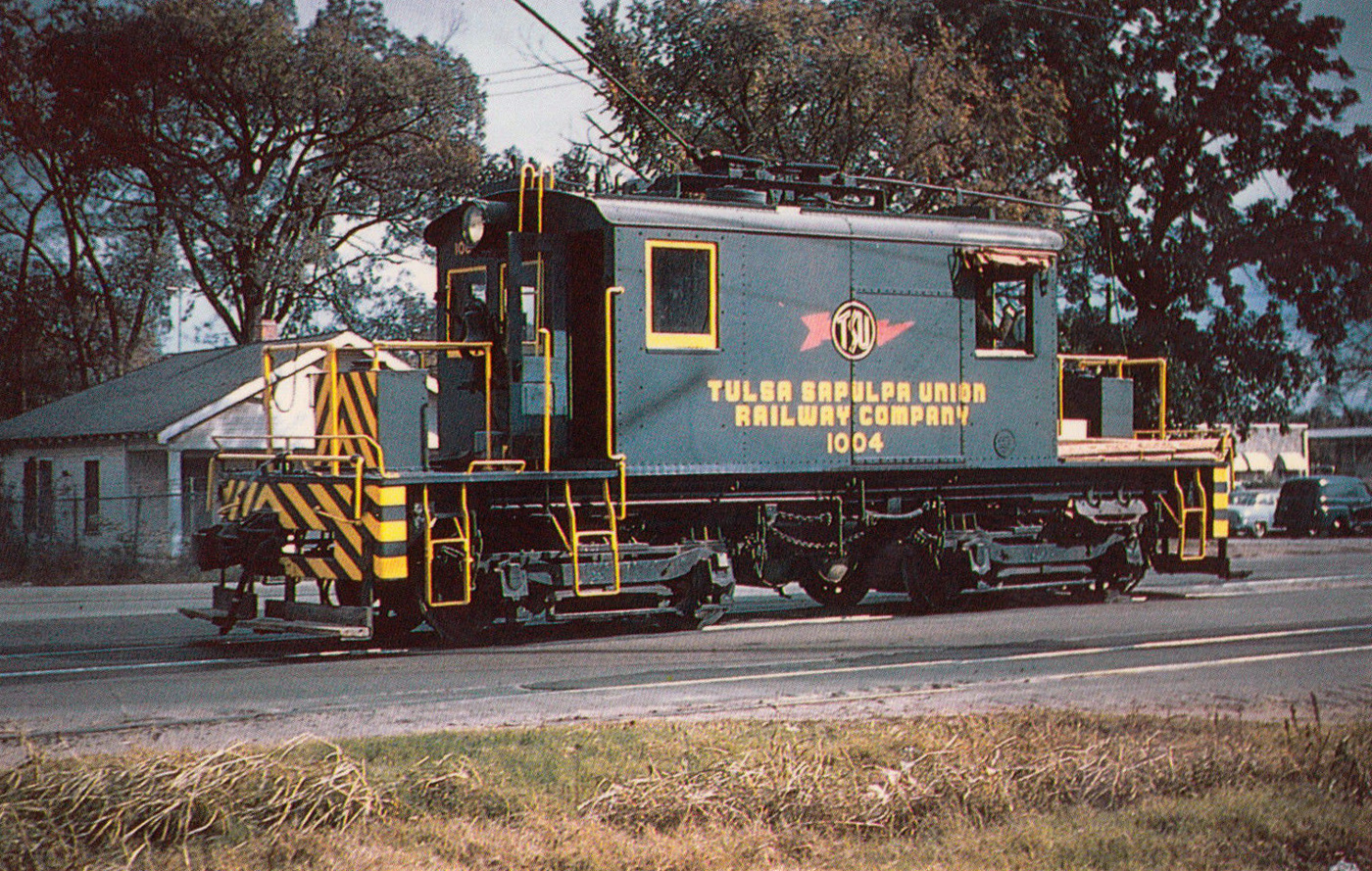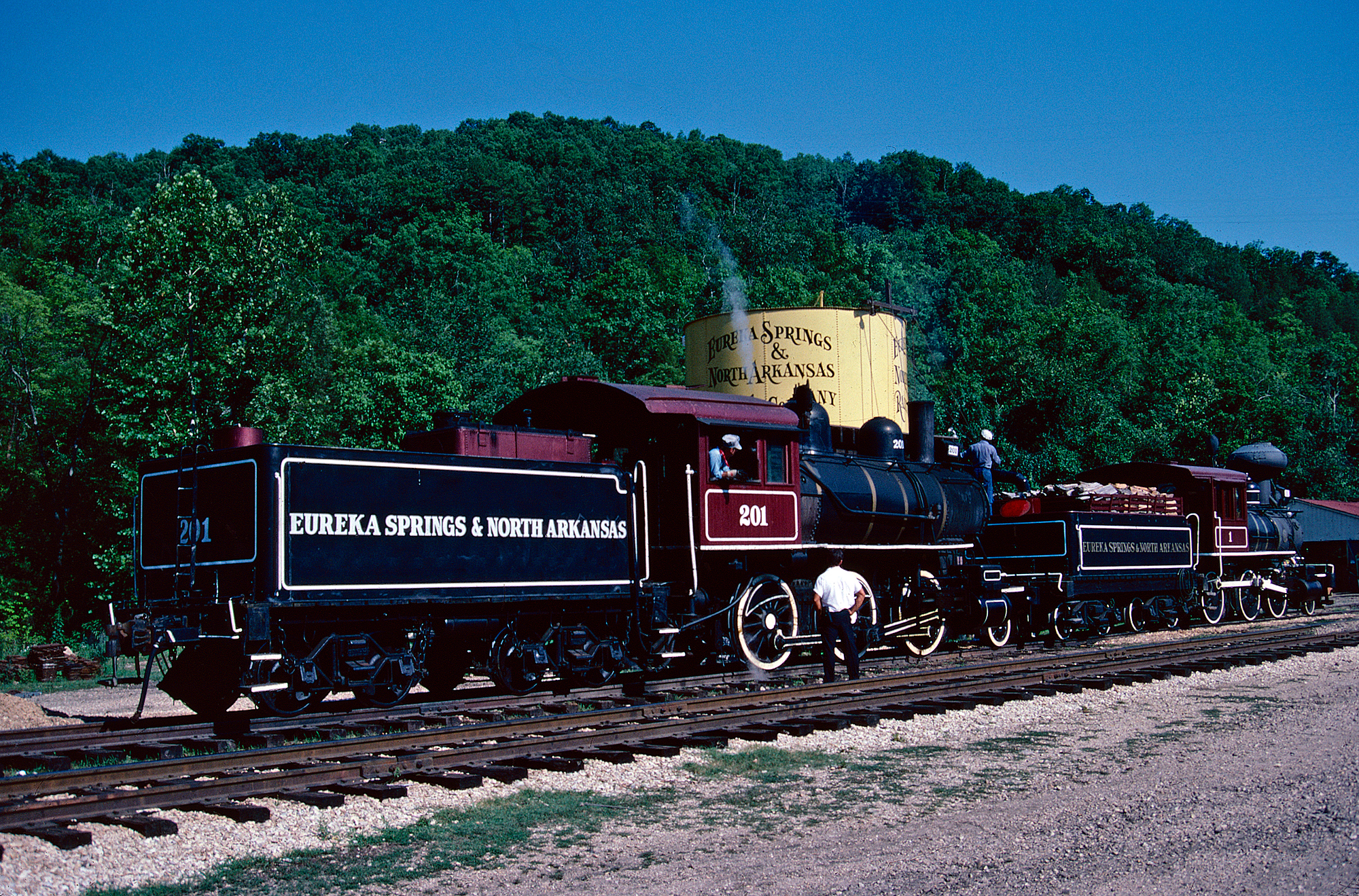- Home ›
- Interurbans ›
- Oklahoma
Oklahoma Interurbans and Streetcars: History, Lines, Photos
Last revised: September 10, 2024
By: Adam Burns
Given its location, Oklahoma had a surprising amount of interurban development. At its peak the state contained 137 miles among a handful of systems scattered from Lawton to Miami and Tulsa.
The largest was the Oklahoma Railway, which radiated out from Oklahoma City to the north, south, and west. It linked Guthrie, El Reno, and Norman with the first segment (El Reno) not opening until early 1911. The system survived longer the most other interurbans, lasting until 1947 when the entire network was replaced by bus service.
Both the Tulsa-Sapulpa Union Railway and Sand Springs Railway developed extensive carload freight business and still survive today as successful short line railroads.
 During the interurban's electrified era, Tulsa-Sapulpa Union Railway 50-ton steeple-cab #1004 (Class B-1) is seen here during the late 1950s. It was built by Baldwin/Westinghouse in 6/28 as Sand Springs Railway #1004 and sold to T-SU in 1955.
During the interurban's electrified era, Tulsa-Sapulpa Union Railway 50-ton steeple-cab #1004 (Class B-1) is seen here during the late 1950s. It was built by Baldwin/Westinghouse in 6/28 as Sand Springs Railway #1004 and sold to T-SU in 1955.Tulsa-Sapulpa Union Railway
The T-SU became one of Oklahoma's larger interurbans. It began service in 1908 connecting Sapulpa, Kiefer and Mounds but fell into bankruptcy just a few years later in 1912 at which point it was merged with the Oklahoma Union Railway.
This interurban had completed a route from Tulsa to Sapulpa giving the entire operation a through line between Mounds and Tulsa (about 25 miles).
Bankruptcies in the late 1920s reorganized the system as the Tulsa-Sapulpa Union Railway by 1943. Interestingly, its freight operations became more profitable as time went on, largely thanks to the regional oil business. Today, it has a much wider array of freight it moves.
Pittsburg County Railway
This small operation eventually served McAlester, Haileyville, and Hartsthorne on a 17-mile system that dated back to a streetcar line of McAlester, which later became known as the Choctaw Railway & Lighting Company.
It was owned by several businesses over the years but became independent by the 1920s. The company was able to build up a somewhat profitable freight business that carried through the end of World War II. It was finally forced to abandon in 1946.
Shawnee-Tecumseh Traction Company
The S-TT was a very small operation using a 6-mile line serving its namesake towns and opening in early September, 1906. Given the small towns it served it was never very profitable although did survive until 1927.
El Reno Interurban Railway
The El Reno Interurban Railway began operations in 1902 serving the City of El Reno. In 1911 the railroad was renamed the Oklahoma Railway and survived until 1933 when streetcar service was abandoned.
Metropolitan Railway
The Metropolitan Railway was Oklahoma City's first interurban beginning operations in 1902.
It lasted only two years before being renamed the Oklahoma City Railway in 1904, which then became just the Oklahoma Railway that same year. This interurban railroad lasted until 1947 and streetcar service was abandoned a year earlier in favor of buses.
Chickasha Street Railway
The Chickasha Street Railway served the town of Chickasha beginning operations in 1910. It remained in service until 1927 when it was abandoned in favor of buses.
Guthrie Railway
The Guthrie Railway was a line that should have never been built. It was meant to serve the town of Guthrie but quickly ran into financial trouble and was abandoned by 1905.
Tulsa Street Railway
The Tulsa Street Railway was the City of Tulsa's primary interurban railroad line. It began operations in 1906 and provided streetcar service until 1928 when it was abandoned in favor of buses.
Lawton & Fort Sill Electric Railway
The Lawton & Fort Sill Electric Railway served the area of Lawton and was the first interurban railroad, becoming the Lawton Railway & Lighting Company in 1912. Streetcar service on the line lasted until 1928 when it was abandoned in favor of buses.
Northeast Oklahoma Railroad
The Northeast Oklahoma Railroad served the Miami area connecting such towns as Commerce, Cardin, Picher, Treece, Cravensville and Columbus. It operated about 23 miles of trackage and remained in service until the 1930s when it was discontinued.
Oklahoma Railway
This interurban had a late start and did begin operations until December, 1911 when it purchased the El Reno Interurban Railway that had recently completed a 29-mile route connecting Oklahoma City and El Reno.
A few years the company had two additional lines radiating from Oklahoma City serving Guthrie and Norman. In total, it was a rather large company owning 78 miles of main line.
After passenger traffic began to seriously decline in the 1920s the Oklahoma finally looked to develop a more serious carload freight business, which it actually became quite successful with.
To help facilitate this business it purchased the small Oklahoma Belt and Oklahoma City Junction Railway. The company was able to stay in operation until World War II when it finally sold the freight lines to the Rock Island and Atchison, Topeka & Santa Fe Railway (the Santa Fe).
Muskogee Electric Traction Company
Another small Oklahoma interurban that connected Muskogee and Gibson on a 10-mile system that opened in 1911. Interestingly, because it was able to build up some freight service the company survived much longer than may have been expected. It was finally abandoned in 1934.
Bartlesville Interurban Railway
This little interurban opened in 1908 on an eight-mile line that connected Bartlesville and Smeltertown. It struggled throughout most of its existence and was abandoned by 1921.
Sand Springs Railway
The Sand Springs Railway dates back to 1911 when it began operations as an interurban railroad and freight line serving Sand Springs and Tulsa on a 32-mile system.
Interestingly the little line survived the interurban fallout that left many systems bankrupt and out of service as early as the 1920s. In the mid-1950s it ended electric operations and switched its locomotive fleet entirely to diesel.
Today, it carries on as a Class III, shortline railroad with connections with the Union Pacific, BNSF Railway and South Kansas Oklahoma Railroad and traffic based in everything from steel and scrap iron to chemicals, paper, plastic and lumber.
Other Systems
Ardmore Traction Company
Cushing Traction Company
Sapulpa & Interurban Railway
Contents
Shawnee-Tecumseh Traction Company
Lawton & Fort Sill Electric Railway
Muskogee Electric Traction Company
Recent Articles
-
Arizona Railroad Museums: A Complete Guide
Apr 16, 25 01:17 PM
Learn about Arizona's rich history with railroads at one of several museums scattered throughout the state. More information about these organizations may be found here. -
Arkansas Railroad Museums: A Complete Guide
Apr 16, 25 12:59 PM
The state of Arkansas is home to a handful of small railroad museums. Learn more about these organizations here. -
Alabama Railroad Museums: A Complete Guide
Apr 16, 25 12:30 PM
Alabama, with its storied past and vibrant connection to the railroad industry, is home to several captivating railroad museums.

